What I’ve done
I've posted different steps in the evolution of the bullet and artillery ammunition throughout the years. I've posted pictures of the different kinds of bullets to help give a visualization.
My best post and why it’s good
My best post is probably "the word 'bullet' is derived..." because I worked hard on that one, and had more info. than the other ones. I was also still in the beginning stages of this project so I was feeling good about it.
What I’d like to improve on
I would like to improve on keeping up with my posts in due time, and to keep the info. accurate and chronological.
What I’ve learned about myself as a learner
I need to keep track of things with a schedule and I can forget things easily.
Where I’d like to go
I want to be more involved in my blog and take time to work on it more. I also don't just want to make it a blog filled with info., I want to make it a personalized blog with my own ideas involved.





